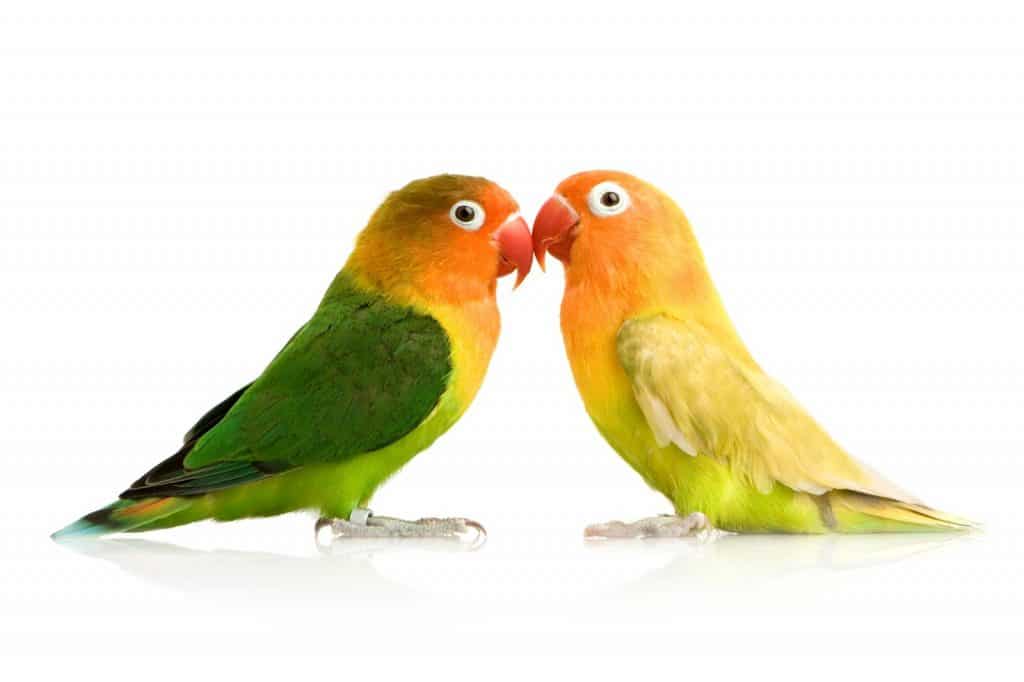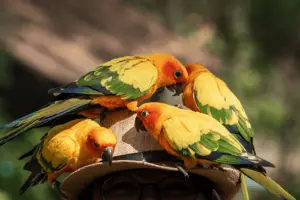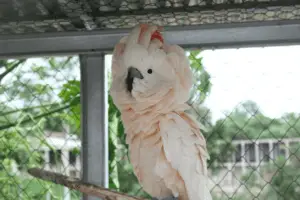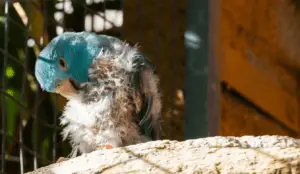Are budgies love birds? There is an inevitable confusion between the two as both are parrot species, and many people use them interchangeably, especially those without enough information regarding avians. However, how similar are they, and what are their main differences?
The budgerigar (Melopsittacus undulatus), also commonly referred to as the budgie, and love birds (the common name for the genus Agapornis) are parrot species. A visual difference between the two is that love birds typically have a shorter tail than the budgerigar’s long tail.
What are the characteristics of the budgie when we compare it to love birds? What are the subspecies of love birds that we ought to know? This article will tackle the critical questions we need to know to answer holistically, “are budgies love birds?”
An Introduction To Budgies And Love Birds: The Similarities
Budgies (or Budgerigar) and love birds are parrot species residing in different parts of the world. However, budgies have become endemic, meaning they live in various environments and are considered invasive species. On the other hand, love birds are a group of birds (not one singular species) grouped under a single category. Like the budgies, certain love birds are near endangered and not endemic.
The love bird and the budgie are similar in looks. Both birds sport a tail with a clean, simple look, which is why both coin them interchangeably with each other. However, aside from that, the budgie and the lovebird are incredibly different. We’ll discuss how different the two are in the following sections of the article.
Are Budgies Love Birds? Origins And Descriptions Of Budgies And Love Birds
Budgies and love birds are different structurally, primarily due to their origins. The original habitats and cultures surrounding animals can significantly influence their behavior and appearance. For example, camels developed humps to survive longer in the desert, and eagles developed an impeccable vision to spot prey in lush jungles.
As for budgies and love birds, we will explore their primal habitats to understand their differences and similarities better. First, let us start with the budgies.
The Origins And Descriptions Of Budgies

Many names know budgies. For example, in the scientific field, budgies are called Melopsittacus undulatus, but their common name is the budgerigar. In American English, they are also called parakeets. (source)
By appearance, they are usually in green and yellow variants, albeit random black markings appear most prominently on their nape, neck, and wings. However, most domestic budgies come in many colors– from blue to white and even gray. Small budgies, or chicks, typically do not have distinct characteristics between genders, making them monomorphic. Budgies also have a long tail that truly distinguishes them from other birds.
In size, most budgies are around 18 to 20 cm from tip to tail. Speaking of its tail, typically, it has a long, slender, dark blue form. Budgies are not particularly heavy; most only weigh 30 to 40 grams. (source)
Budgies, like most parrots, can mimic human speech. Because of their massive populations, many have seen the budgie in many colors, a stark difference from the original selection of green and yellow.
The budgies have made a significant contribution to the field of genetics and science. Budgies have served as the initial test subjects for Greg Mendel’s studies on genetic inheritance.
As for their primal habitat, budgies originated in Australia, specifically in the interior of the West Dividing Range, and are not very common in coastal areas. Budgies typically form flocks, and said flocks could be as small as three to four but as large as a few hundred to thousands.
Fundamental Information Regarding Budgies
- The budgie’s full name is the budgerigar, and many in the Americas refer to them as the parakeet. Scientifically, they are known as the Melopsittacus undulatus.
- While many budgies are yellow, they come in various colors due to mutations.
- They are monomorphic, meaning they have young species that do not have differentiating characteristics, whether male or female.
- They are 18 to 20 cm in height and can be as heavy as 40 grams. They have long, slender tails.
- Budgies can mimic human speech.
- Budgies originated from Australia.
The Origins And Descriptions Of Love Birds

Are budgies love birds? The love bird (also stylized as “lovebird“) is a group of species belonging to avians of the Agapornis genus. Nine species belong to the genus, all native to the African continent. A particular lovebird species, the grey-headed lovebird, originates from the African continent of Madagascar. (Alderton, D., 2003)
Why are love birds called “love birds”? Many people call love birds due as love birds due to their tendency to be monogamous or that they stick to one partner. Aside from such, they are also known for sitting with their partners on one branch for long periods.
Love birds come in different colors due to mutations through breeding. In addition, love birds can be yellow, peach, violet, teal, white, and even orange. Typically, most love birds last for 20 to 30 years, as they are long-living species.
Regarding its physical description, the lovebird has the following physical dimensions: approximately 6 inches in height (13 to 17 cm) and can be up to 60 grams in weight. They are one of the smallest parrots, have a blunt, colossal beak, and sport a short tail. We formulated a list below to summarize the essential information regarding love birds. (source)
Fundamental Information Regarding Love Birds
- The term “love bird” does not refer to a single species but is a subspecies of parrots under the Agapornis genus.
- Love birds are native to Africa. Certain species are native to the African island nation Madagascar.
- People call love birds “love birds” due to their monogamous nature and tendency to stick with their partners for long periods on a single branch.
- Due to mutations resulting from breeding, they come in various colors, from peach to white.
- Love birds live for approximately 20 to 30 years.
- They are 6 inches in height and 60 grams in weight and are considered one of the smallest parrot species, having large beaks and short tails.
Are Budgies Love Birds? The Main Differences Between The Two.
As we have discussed earlier, aside from a few characteristics, such as being birds and parrots and looking similar, both species do not have a lot of things in common. As such, we will discuss the differences in a bullet list below.
What Are The Main Differences Between The Budgie And The Love Bird?
- Physical appearance-wise, the budgie is slightly bigger than love birds.
- The budgie has a long tail; love birds have a smaller tail.
- Budgies are talking birds, meaning they can mimic human speech. However, love birds do not carry this ability. (source)
- The budgie is native to Australia but is endemic around the world. On the other hand, love birds are native to Africa, but like a budgie, they can also be found in many regions worldwide.
- The budgie is a more common pet compared to lovebirds.
What Species Are Considered As Love Birds?
As stated throughout this article, love birds are a group of birds under the Agapornis genus. However, what are the specific parrot species under this genus? We’ll list the nine below. (Le Breton, K. 1992)
The Nine Species Of Love Birds
- Fischer’s lovebird (Agapornis fischeri): Native to Northeast Tanzania, with blue tail feathers and a yellow and green body, typically 14 cm (5.5 inches) long
- Black-cheeked lovebird (Agapornis nigrigenis): Like the Fischer, they are also usually 14 cm (5.5 inches) long, with brown-blackish cheeks. They also have white eyerings, an orange upper chest, a red beak, and a reddish-brown forehead and forecrown.
- Yellow-collared or masked lovebird(Agapornis personatus): Native to Northeast Tanzania, they are also 14 cm (5.5 inches) long and have blue tail feathers with a yellow and green body.
- Lilian’s lovebird or Nyasa lovebird(Agapornis lilianae): They are approximately 5 inches long (13 cm) and are native to Malawi. Typically in a green body with a red beak.
- Lack-winged lovebird or Abyssinian lovebird(Agapornis taranta): They are bigger than typical lovebirds at 6.5 inches (16.5 cm) long and native to Southern Eritrea and southwestern Ethiopia. They have a red beak, and while the females are all green, the males have a red forehead.
- Black-cheeked lovebirds (Agapornis nigrigenis) are typically 5.5 inches (14 cm) long. They have a red gradient from the head to the shoulders. They have a green body aside from the gradient areas.
- Grey-headed lovebird or Madagascar lovebird (Agapornis canus): Native to the island nation of Madagascar, they are small at 5 inches (13 cm) and have a green lower body, with an even greener back. They get their name from their pale beak, and the males sport a gray upper body.
- Red-headed or red-faced lovebird (Agapornis pullarius): typically 6 inches (15 cm) long and native to the central part of Africa, they have a green body with a reddish head. Male red-faced lovebirds have a more prominent red on their head and beaks.
- Black-collared lovebird or Swindern’s lovebird (Agapornis swindernianus): They are native to Equitorial Africa and are 5 inches long. They are primarily green with a black section on the nape and have a dark beak.
Are Budgies Love Birds? The Behavioral Differences Between The Two.
While visual differences are a clear giveaway of the differences between the budgies and the love birds, when you decide which one is better for you to get as a pet, it will be integral to investigate their behaviors and tendencies. After all, noise levels, aggression, and maintenance can decide which of the two is better suited for you. This section will list the subtler differences between the two parrots.
Behavioral Tendencies Of Budgies Vs. Love Birds
- Budgies tend to make two types of noises, one pleasant to the ears and used as a communication method, also called the “babble” sound. This sound is often associated with random chatter at normal sound levels. Meanwhile, when agitated, budgies can produce a more robust sound, but in rarer instances at that.
- Love birds can only create one type of sound, which is more potent than the budgies, and they use it in all instances: communication, fear, hunger, and display of affection. As such, love birds are harsher to the ears compared to budgies.
- Love birds can have a more substantial bite compared to budgies.
- Budgies tend to jive well with other bird species. They can form positive relationships and strong bonds with those out of their flock.
- On the other hand, despite being called “love birds,” they can be highly aggressive to those outside their flock.
- Because love birds are harder to take care of compared to budgies, they tend to be a less popular option as pets.
Summary
Are budgies love birds? The budgie, a bird of many names as it is called the parakeet in some regions, the budgerigar for some, and Melopsittacus undulatus for the scientific community, is a bird species native to Australia. Budgies typically are a small species, approximately 18 to 20 centimeters or 7 inches from tip to tail. In fact, many weigh only 30 to 40 grams. In addition, budgies can mimic human speech and are considered endemic in many parts of the world due to their booming population.
On the other hand, love birds are not a specific species per se but are subspecies of the genus of Agapornis. The Agapornis subspecies have nine species, ranging from Fischer’s lovebird to the red-faced lovebird. They are native to Africa, and most reside around Tanzania. Typically, they sport a green body, but certain species have red markings, and some even have gray spots.
Unlike budgies, love birds cannot mimic speech. Most love birds are more aggressive and are noisier compared to budgies. As a result, parakeets are a more popular option as pets. However, many experts consider the budgie invasive due to its swift adaptability and continuous breeding.
- “Budgerigar.” Birdlife Australia. Archived from the original on June 3, 2020. Last Accessed June 24, 2022. https://www.birdlife.org.au/bird-profile/budgerigar
- “Budgerigars,” Bush Heritage Australia, last accessed June 24, 2022. https://www.bushheritage.org.au/species/budgerigars
- Alderton, David (2003). The Ultimate Encyclopedia of Caged and Aviary Birds. London, England: Hermes House. pp. 216–219. ISBN 1-84309-164-X.
- “Lovebird,” Animal Network, last accessed June 25, 2022. https://animals.net/lovebird/
- Le Breton, Kenny (1992). Lovebirds…getting started. USA: T.F.H. Publications. pp. 84–98. ISBN 0-86622-411-4.










